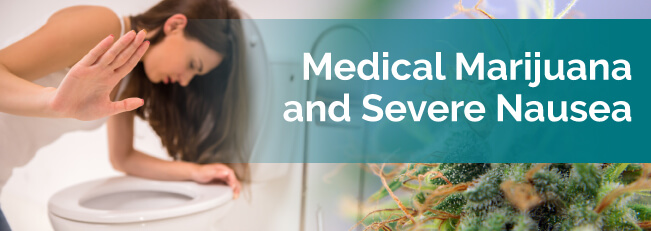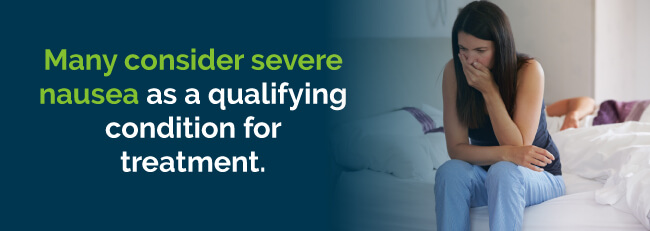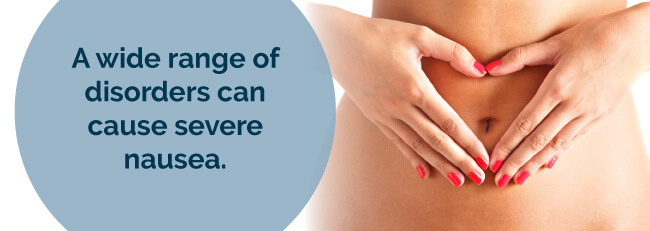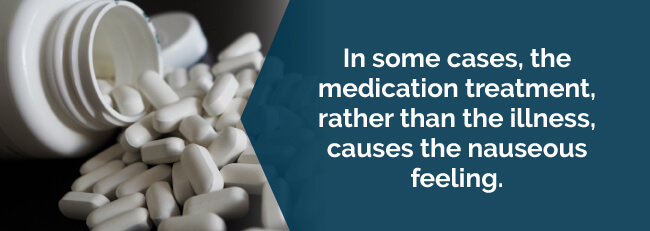
We’ve all had an upset stomach before. But some patients experience chronic and severe nausea that gets in the way of living a quality life. It can be caused by an underlying disorder, or it can function as its own condition. Sometimes, even medication and treatment meant to address a different condition can cause chronic nausea.
Regardless of the cause of your severe nausea, it makes it difficult to deal with your other symptoms. That’s where we come in. We believe medical cannabis can be an ideal treatment for severe nausea. To help you make an informed decision about the options available to you, let’s review some of the facts about medical marijuana and its usefulness in treating nausea.
We’ve studied the effects of cannabinoids on nausea for decades. In a 1975 study, Sallan, Zinberg and Frei found that all 20 of their subjects found relief from nausea when they used certain types of THC, one of the chemicals in marijuana. More recently, Rock, Sticht, Duncan, Stott and Parker found that a type of CBD also has antiemetic potential.
Research has shown conclusively that medical marijuana, including cannabinoids and THC, works as an antiemetic. In some cases, it works better than other medications prescribed for nausea.
It has also been used together with other antiemetics to great result. Studies combining medical marijuana with other prescription antiemetics revealed that combining these antiemetics increased the effect of both, showing that it can be used as a stand-alone antiemetic or together with other antiemetics in cases that require more results.
Find A Doctor Find A Dispensary
The United States Drug Enforcement Administration is charged with controlling the use of narcotic drugs in the United States. One such drug is marijuana.
Even this agency has admitted to the importance of research in the area of marijuana as a medication. They do not interfere with the use of Marinol for nausea in patients with prescriptions. Marinol contains synthetic THC, the psychoactive component in marijuana.
This is a large step toward federal legalization of many forms of medical marijuana. However, it is slow going. The DEA claims to be supporting medical research in the field, but very few marijuana medications are approved by the federal government, and they can only be used in very specific cases.
Interestingly, the FDA has come out with statements in the past six years that say they have found absolutely no medical use for marijuana. What is most interesting about that is the FDA has approved synthetic medical marijuana for nausea, vomiting and wasting associated with AIDS and chemotherapy.
Marinol has been approved by the FDA since 1985! As of now, that is more than 25 years of FDA approved medical marijuana usage and yet, there is a lot of political backtracking.
Medical marijuana clearly has a use if it has such a longstanding history of medical use for nausea. Furthermore, even synthetic derivatives of the plant are derivatives of the plant, thus proving that medical marijuana has at least one use — research — though it certainly has many more.
Marijuana’s greatest strength lies in its versatility. Nausea often comes with other symptoms, and instead of taking an assortment of pills for every single one, you could use medical marijuana.

Let’s look at some common related symptoms and how marijuana can ease them:
Before we get into the specifics about particular strains that help with severe nausea, we need to start with the basics. Using medical marijuana is more complicated than you may think, especially if you don’t know much about cannabis. Rather than using just any kind of marijuana to medicate yourself, contact a doctor who can give you more information about the proper type, or strain, of cannabis that can treat the exact symptoms you have.
While there are thousands of marijuana strains out there, they all come from two families — sativa and indica. Sativa boosts your energy and mood, and indica calms you down and helps you sleep. Marijuana cultivators also crossbreed different strains to make hybrid strains that take on the properties of their parent strains.
Any family of marijuana strain can treat nausea, but some strains in particular treat it better than others. Some of the most popular strains that treat nausea include:
All in all, the only people who can make the right call for what marijuana strain will help you the most are you and your doctor. Consult with a doctor often and ask questions about which strain might be right for you.
In addition to picking a medical cannabis strain to use for treatment, you must figure out the best way to use it. Every consumption method affects you differently, and the right kind of treatment for you depends on many factors. Considering how many medication options you have, you’re sure to find something that works for you.
Inhaling marijuana provides the quickest effect, which is useful when you suddenly feel nauseous and need immediate relief. However, both smoking and vaping can release dangerous toxins, although vaping produces much less of them. If you can delay the effects a little, you may want to consider a different option.
If you can wait a little longer, you can use a tincture, one of the classic ways to medicate with marijuana. A tincture is a solution of glycerin or alcohol with medical cannabis that you absorb under your tongue. Tinctures kick in faster than edibles, but not as fast as inhalation.
Since nausea doesn’t come from the skin, many topicals aren’t ideal for treating nausea since they only penetrate skin-deep. Patches, on the other hand, medicate directly into your bloodstream. You have to wait for the effect to build up, but they provide an extended release.
Edibles are also very situation-specific. They can take over an hour to affect you. However, if your stomach is specifically causing the nausea, an edible consumption method will go right to the source. Because of this, edibles can work when you don’t experience sudden and intense nausea, and you don’t want your medicine to come right back up again.
To find the best option for you, you must consider how your symptoms happen and what your body’s needs are. Even if you think you have a good idea, keep in touch with your doctor and dispensary and consult them regularly. They can advise you on how each type of consumption will affect you and what to do if something doesn’t work out.
When you use cannabis for medical purposes, keep in mind that it has side effects. However, these side effects tend to cause less discomfort than the side effects from some traditional medicine. In addition, some patients seek out some of these effects as a treatment, such as increased appetite or sleepiness.
When in doubt, talk with your doctor about using your cannabis meds at a different time or changing the strain you use. Don’t worry if your treatment plan doesn’t work out right away. Not every patient will find the right fit on their first try. Keep talking to your doctor and trying new treatments.
Information is key to getting a good start on your medical cannabis medication experience. Once you have the basics down, you can fill in the gaps in your knowledge by doing further research or asking an expert.
Before you fill out any forms or make a purchase, research your state’s marijuana laws. Every state has a possession limit and rules about where you can and cannot take your meds. You don’t want to do anything illegal unintentionally.
Once you’ve done some research, your next step is to pick a medical marijuana-friendly doctor who can write a recommendation for you. You will have an ongoing relationship with them, so choose wisely. They’ll have to regularly renew their recommendation for you, and you may also need to consult with them regularly about the different options you want to explore.
Depending on your state’s laws, you may have to designate a primary dispensary or find one to try out. In some states, you must choose a dispensary when you apply.
Our aim at Marijuana Doctors is to inform patients about the medical marijuana process and make them aware of their choices. We hope that by becoming more aware of the options and treatments available, you feel more empowered to seek the treatments you need for your severe or chronic nausea.
Find A Doctor Find A Dispensary
While often associated with the stomach flu, pregnancy and gastrointestinal disorders, nausea can be a major symptom or side effect of blood sugar disorders, anxiety disorders and more. When a patient experiences severe nausea, they can feel intensely queasy, constantly sick to their stomachs or they may experience frequent vomiting.
Depending on the nature of your health problems, severe nausea can occur as a response to certain triggers like medication or a panic attack, or it can occur chronically as a regular part of your condition. It can happen predictably or unpredictably, and it may manifest itself differently in different patients.
No matter what causes it, severe nausea interferes with all sorts of daily living activities. It’s difficult to maintain an ordinary routine when you’re in constant discomfort. It’s also difficult to develop healthy eating habits when your stomach can’t keep most food down. This is harmful especially if you’re fighting an illness, when your body needs nutrients to help fight the sickness.

Fortunately, medical marijuana could give you the relief you need. Many of the states that permit medical marijuana use consider severe nausea as a qualifying condition for treatment. In addition to treating the symptom of nausea, medical marijuana could also treat some of the other health problems you deal with.
A wide range of disorders can cause severe nausea. Nausea can be the primary symptom of a disorder or a secondary symptom that’s not the focus of the health problem.

Medical marijuana-eligible conditions that directly cause severe nausea include:
Sometimes, when we try to medicate an illness, the medication ends up causing some symptoms itself. In these cases, the treatment, rather than the illness, causes the nauseous feeling.

The treatments for the following conditions can cause nausea as an unintended side effect:
When your run-of-the-mill antacid won’t do the trick, your doctor might prescribe an antiemetic, or anti-nausea medication. Each kind of antiemetic has its own set of benefits and side effects, and affects the area of the brain that causes your nausea. The families of antiemetics include:
Your doctor must determine the right antiemetic with care, taking into account your health problems, the nature of your nausea and the potential side effects. In contrast, medical marijuana causes similar or less severe side effects without the trouble of deciding the right area of the brain to treat.
The synthetic medical marijuana medications nabilone and dronabinol have been given for nausea for several years. They are shown to reduce nausea in the majority of patients, even those who have been resistant to antiemetics in the past. Their main use is for nausea and vomiting associated with chemotherapy. There is documentation of side effects such as feeling tired and dizzy. A doctor and patient together can decide if these effects are worth reducing or eliminating nausea.